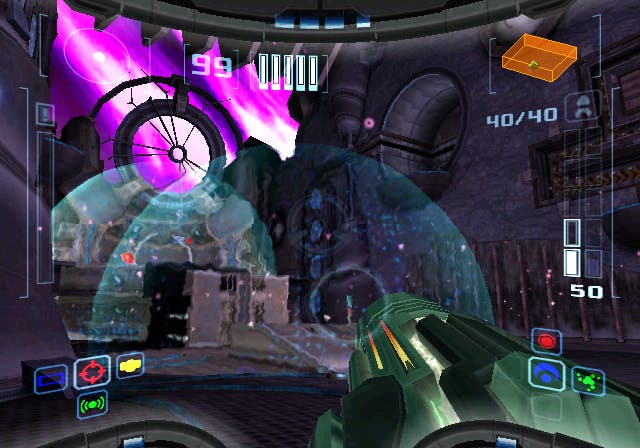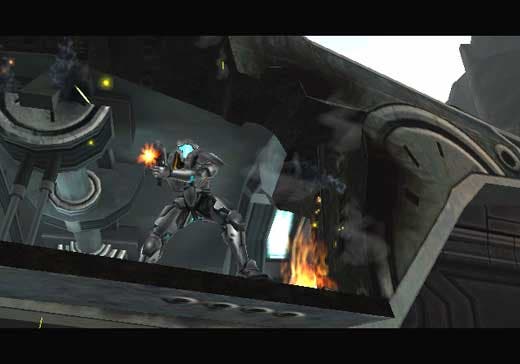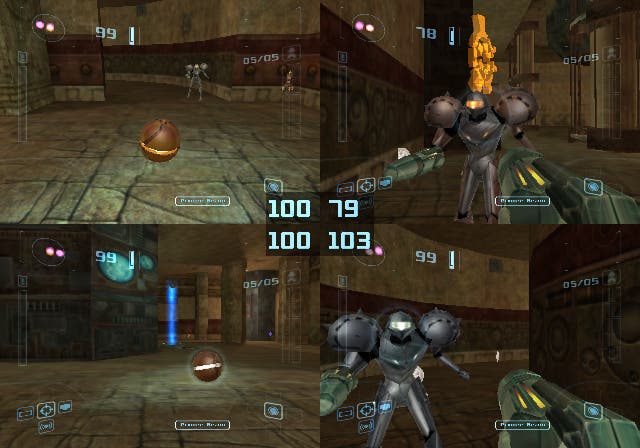Metroid Prime 2: Echoes
How do you build on Metroid Prime, and make it work in multiplayer? We try and find out by going hands-on against Space Pirates and other journos.
The Japanese are going to have to wait. Whereas last time out, those of us in Europe were forced to endure an infuriating delay of several months before getting our hands on Metroid Prime, for the inevitable sequel, Nintendo is planning to release the PAL version at roughly the same time as its American counterpart. Crucially, that means we should see it before Christmas. The Japanese release has reportedly been bumped to 2005 to accommodate us.
Primordial soupcon

This seems to be a growing trend. Daft delays are still a problem (Mario Golf, for example), but some of Nintendo's highest profile titles are starting to appear in Europe in line with the firm's overseas output - Mario Kart: Double Dash!! being the most obvious example. It's encouraging. But, in these days of a FreeLoader in every other Cube and low-cost importers in every bookmarks folder, punctuality wasn't our biggest worry about Metroid Prime 2: Echoes.
Instead, going into our first encounter with Retro Studios' adventure sequel, we were conscious of another growing trend amongst Nintendo titles - samey sequels. MP2 doesn't veer stylistically away from its predecessor in the same way new Zelda sequels do. In fact, with relatively little time to seek out upgrade capsules, Retro has designed a game that looks and feels largely the same to play - a bit more vibrant, perhaps, with a shinier suit, but in our mind's eye at least, intimately familiar. And with unchanged controls - the left analogue stick still moves Samus, with L locking onto objects and enemies, R for manual aim, A to fire, B to jump, Y to fire missiles, and D-pad and C-stick for switching visor modes and weapons respectively.
Tackling this problem of similarity in mechanics and presentation obviously requires new gameplay ideas. One of these is the curious addition of multiplayer (of which more a bit later), but in terms of the single player adventure, the most obvious change is a by-product of Metroid's new environment - the way Samus Aran handles the twinned dark and light realms of the planet Aether, where the famous bounty hunter has been sent to try and find a Galactic Federation trooper unit.
Dark skies ahead

Aether is split into two realms that struggle to deal with one another. On each side, an indigenous race struggles for control and penetration of the other side - the light folks want to scuttle their continuing conflict with dark side demons the Ing, who in turn want to do much the same, except their single minded objective is to find a way of existing painlessly in the light world, in order to vanquish their adversaries for good and control Aether completely. Soon after landing, Samus finds herself on the light side of things - equipped with twin, limited-ammo light and dark beam weapons that enable her to tackle problems on either side.
Although we have a feeling some of Samus' new visors (including a sort of visual sonar) and the possible of addition of new suits will figure highly in the evolution of MP2's combat and puzzles, in the framework of the demo we've played the light and dark beams are the most significant additions. Stepping through a portal and into the dark realm, the light beam becomes key to making progress. Even Samus' well armoured suit can't take much exposure to the dark world's oppressive atmosphere, so the light beam has to be used to create pockets of tolerable atmosphere, targeting crystals suspended in the air to create little safety bubbles, and dodging between them.
Combating the local dark fauna similarly hinges on use of the opposing beam. While the dark beam can take them down, the light beam - which sprays not unlike a shotgun - is most effective. Nameless dark adversaries regularly appear as black, purple-edged pools of liquid, which crawl over the floor and ceiling seeking a vantage point, before bubbling and erupting into spidery form, at which point they become susceptible to attack. A few shots from the light beam bring them down.
Although for the moment the light beam is key to probing and tackling the dark side of Aether, we also understand both beams will figure highly in environmental puzzles, where the light beam can be used to culture the Aetherian flora, while its opposite number - which engulfs enemies in black goo, freezing them in moderation or killing them in saturation - can be used for destroying it and breaking down natural obstacles.
Juggling

All that said, it's difficult to know whether the demo level is an accurate reflection of the rest of the game - largely due to Retro's quietness on the subject. We have a feeling it's just the tip of the iceberg. What we do know, based on our run through, is that Space Pirates will figure in some way - early skirmishes with walking and flying Pirates are quite involved, as they chase Samus doggedly around a light world facility; and judging by the equipment we scanned, they're trying not only to harness the dark Aether's abundance of Phazon, but to capture and breed Metroid larvae, which generally becomes a problem when they escape and run riot...
We also know that the morph ball (still bound to X) features heavily. And daintily of course - the physics are still a joy to experience. In the demo, Samus not only has to use the ball to power the odd switch and move through small holes to reach new areas, but there is a clever section where she's rolling around beneath metal gratings, dodging laser fences and hunting down missile expansion capsules, while unwary Space Pirates stroll across the floor above her. Just after that, she's tackling a 2D, side-on maze, using bombs to jump between timed laser beams and blast holes. We also understand that the morph ball will be used to cannon Samus over huge chasms from time to time - a feature originally designed for the multiplayer mode.
Perhaps disappointingly, the demo didn't give us much of a chance to judge MP2's puzzling, but this is presumably because Retro wanted players to reach the end of it, rather than there being any question of less puzzling this time out. As such, the extent of it was a few switches to throw and a jumping puzzle, which made use of the bounty hunter's double jump to send her up to a higher doorway. Later on, we look forward to using the returning Screw Attack and Wall Mount abilities to jump between walls and scale this sort of incline in another way.
One thing we did get to sample in the demo was a boss encounter - in this case, a climactic showdown with Dark Samus, who you may remember from Metroid Fusion. Although her role in the game is yet to be determined (and won't be as significant as you might imagine, according to Retro), Samus' black-suited twin is clearly drawing power from Aether somehow. Facing off with Samus, she hovers in the air coated in a sort of protective shield, and dive-bombs her nemesis, often blowing chunks out of the scenery in the process. Once she's on the ground she's not that hard to beat, fortunately for us, and particularly vulnerable, as you might imagine, to light beam attacks, but we have a feeling it won't be the last time we lock horns with her.
Groupthink

But of course, given its demonstrable similarity to its predecessor, the MP2 demo's yin-yang inspired sojourn into the world of Aether was arguably less exciting for us than the opportunity to examine the game's multiplayer mode up close. While we're encouraged by the steps Retro is taking to oblige single players, multiplayer Metroid is brand new, and we were keen to see how the developer had managed to take a lock-on-based action game - shot from the first-person perspective - and turn it into a balanced, enjoyable multiplayer game.
Naturally our experience with Metroid Prime: Hunters on the DS put us in good stead, but in the end the Cube is the clear victor. Disappointingly there's no LAN mode - just split-screen for two to four players - but we didn't have much time to think about that once we got going. In practice, the game is surprisingly balanced despite weapon-locks, relying on a mixture of locked beam attacks, evasive morph ball manoeuvres and power-ups to succeed. Before long, whenever we found ourselves caught in the open and on the verge of taking a hit, we stabbed X instinctively and boosted our way out of the firing line, sometimes responding with a Death Ball power-up, or taking form just in time to wheel out a power-up that increases the strength of the beam or gives us unlimited ammo or invulnerability.
Another nice idea is the use of the visor to steal power-ups - effectively 'hacking' rival bounty hunters from afar - and, despite the one-stick FPS control scheme, the decision to use tiered levels doesn't seem unnatural, and moving between them in ball mode or using the grapple beam is quite intuitive. In the end, fleeting though it was, our experience of Metroid Prime 2 multiplayer left us quite excited - not only does it have several game types (including, in addition to standard Deathmatch, a "Bounty" mode where you collect tokens dropped by damaged opponents), and draw cleverly on various aspects of the single player game, but it does so with a level of balance that feels unusual for what's arguably an unusual skew on FPS multiplayer. We're keen to see how it ends up.
Good vibrations
Indeed, that's true of the game at large. Faced with the task of rebuilding Prime using many of the same technological elements, Retro Studios seems to have some good ideas on the boil, and although it's unlikely to have the same impact on the genre as its high concept predecessor, it's still assuredly Metroid. That, coupled with the promise of a pre-Christmas release, ought to be enough to hold most gamers' attention.

